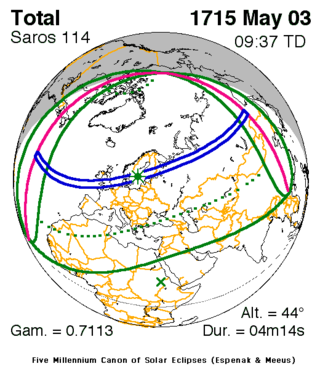Solar eclipse of May 3, 1715
| Solar eclipse of May 3, 1715 | |
|---|---|
| Type of eclipse | |
| Nature | Total |
| Gamma | 0.7112 |
| Magnitude | 1.0632 |
| Maximum eclipse | |
| Duration | 254 sec (4 m 14 s) |
| Coordinates | 59°24′N 17°54′E / 59.4°N 17.9°E |
| Max. width of band | 295 km (183 mi) |
| Times (UTC) | |
| Greatest eclipse | 9:36:30 |
| References | |
| Saros | 114 (60 of 72) |
| Catalog # (SE5000) | 8826 |
A total solar eclipse occurred on 3 May 1715. A solar eclipse occurs when the Moon passes between Earth and the Sun, thereby totally or partly obscuring the image of the Sun for a viewer on Earth. A total solar eclipse occurs when the Moon's apparent diameter is larger than the Sun's, blocking all direct sunlight, turning day into darkness. Totality occurs in a narrow path across Earth's surface, with the partial solar eclipse visible over a surrounding region thousands of kilometres wide. This total eclipse was visible across England, northern Europe, and northern Asia.
This total solar eclipse was observed in England from Cornwall in the south-west to Lincolnshire and Norfolk in the east. It was also observed in Ireland, where large crowds turned out in Dublin to watch it: the weather in Dublin was exceptionally cold and wet, and the eminent judge Joseph Deane caught a fatal chill as a result.
This eclipse is known as Halley's Eclipse, after Edmond Halley (1656–1742) who predicted this eclipse to within 4 minutes accuracy. Halley observed the eclipse from London where the city of London enjoyed 3 minutes 33 seconds of totality. He also drew a predictive map showing the path of totality across England. The original map was about 20 miles off the observed eclipse path, mainly due to his use of inaccurate lunar ephemeris. After the eclipse, he corrected the eclipse path, and added the path and description of the 1724 total solar eclipse.
Drawing upon lunar tables made by the first Astronomer Royal John Flamsteed, William Whiston produced a more technical predictive eclipse map around the same time as Halley. Both Halley's and Whiston's maps were published by John Senex in March 1715.
...
Wikipedia

